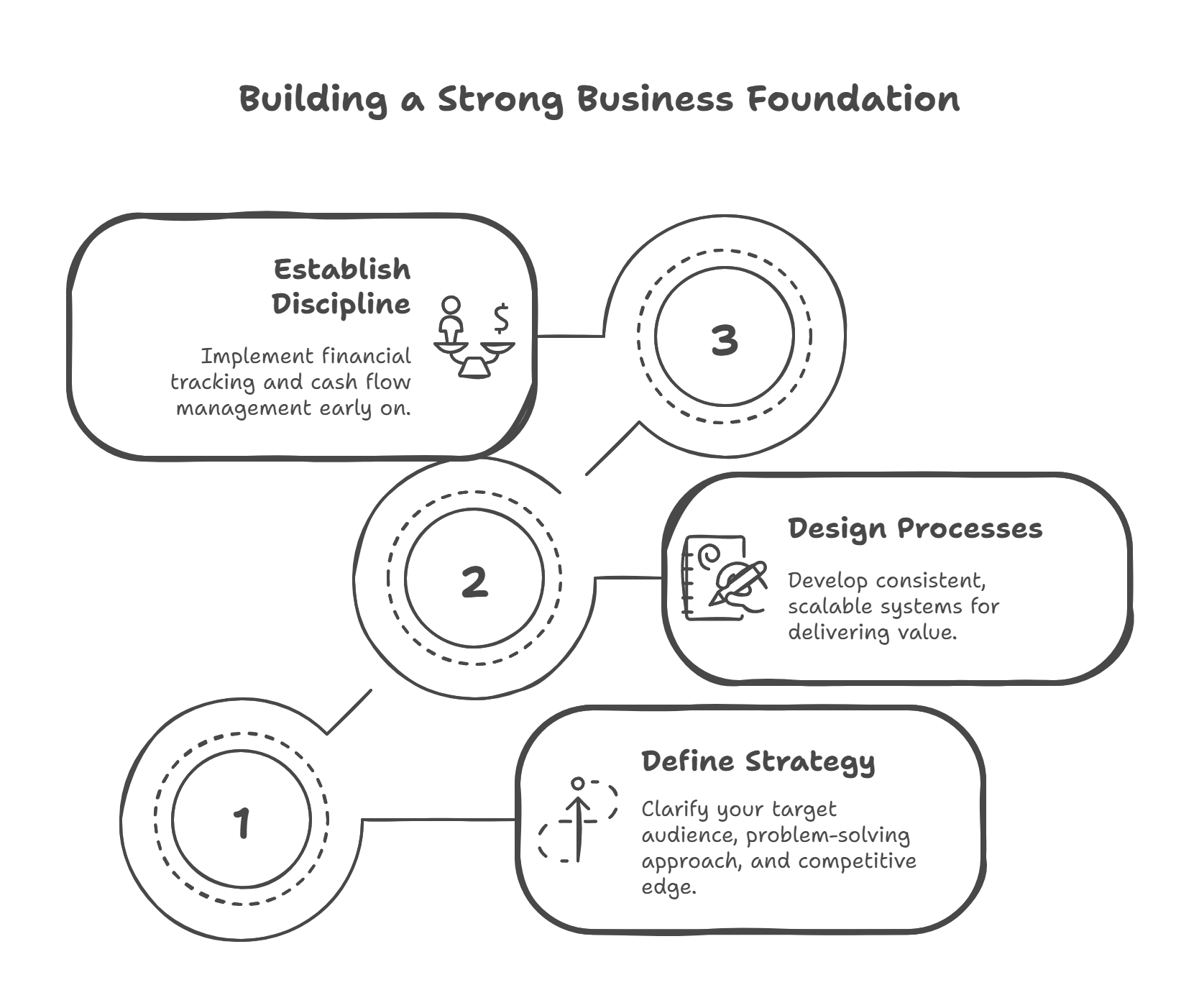Forget surface treatments. Discover why tackling foundational flaws holistically is the only path to sustainable health and escaping the endless cycle of crisis.
Okay, let’s have a real conversation. Forget the noise, the gurus, the endless stream of ‘hacks’ promising overnight success. Just you and me, talking about the guts of your business and why, despite all your effort, it might feel like you’re perpetually stuck in a cycle of near-misses, putting out fires, and wondering when things will finally click and feel stable.

You’re smart, you work harder than almost anyone you know, and you genuinely care about what you’re building. Yet, the pressure is relentless, isn’t it? The cash flow worries, the team frustrations, the nagging feeling that one wrong move, one unexpected market shift, could bring the whole thing crashing down. So, what do you do?
You do what seems logical: you patch the most significant leak. You fix the most immediate problem screaming for attention. You slap a Band-Aid on the symptom because digging deeper feels too overwhelming, too time-consuming, too… much.
And that, right there, is the seductive lie. The lie of the ‘quick fix’. The belief that you can somehow patch your way to prosperity, fixing isolated problems on the surface while ignoring the fundamental, structural integrity of your business underneath. I’m here to tell you, with all the conviction I possess, that approach is doomed. It keeps businesses fragile, leaders stressed, and potential untapped.
There’s a better way. It’s harder, requires more discipline, and is decidedly unsexy. But it’s the only way. It demands you stop thinking like a patch-up artist and start thinking like an architect, embracing the holistic power of what we call the Triangle Advantage.
The Fallacy of the ‘One Leg Fix’: Why Improving Strategy or Ops or Finance Isn’t Enough
You’ve heard the advice: “Get your strategy right!” or “Focus on operational efficiency!” or “Cash is king – sort out your finances!” And each piece of advice, in isolation, sounds reasonable. The problem is, your business isn’t a collection of isolated parts; it’s an interconnected system.
It’s a three-legged stool.
Trying to achieve stability by obsessively polishing just one leg while the others are cracked and wobbly is utterly futile. The whole thing will tip over eventually, usually at the worst possible moment.

Let’s break down why these partial solutions are fool’s gold:
The Strategic Genius with No Engine Room
Picture this: You’ve crafted a brilliant strategy. Crystal clear vision, perfect market positioning, innovative ideas that could change the game. You’re a strategic visionary! But… your operations are chaotic. Processes are undefined, reliant on individual heroics. Your team doesn’t have the systems or training to execute consistently. And your financials? Shaky. You don’t have the data to track progress accurately or the resources to fund the strategy properly.
What happens? Your brilliant strategy remains largely theoretical. Execution falters. Deadlines are missed. Quality is inconsistent. Costs spiral out of control because of inefficiency. You burn through cash chasing a vision that your business structure simply cannot deliver. You’ve got a Ferrari brain plugged into a lawnmower engine. Great ideas, zero reliable traction. It’s a recipe for frustration and eventual failure, despite the strategic brilliance.
The Operational Powerhouse Adrift
Or maybe you’re the opposite. Your operations are slick! You’ve got processes down pat, Six Sigma black belts roaming the halls, efficiency metrics that would make Toyota weep with joy. Your engine room is humming. But… your strategy is fuzzy, or worse, wrong. You haven’t clearly defined your ideal customer or unique value proposition. You’re efficiently producing something the market doesn’t desperately want, or you’re constantly reacting to competitor moves instead of charting your own course. And maybe your financial controls are loose, so you don’t even realise your efficient machine isn’t actually profitable.
What’s the result? You’re incredibly busy, producing output flawlessly… but it’s potentially the wrong output, aimed at the wrong market, or generating insufficient margin. You’re a ‘busy fool,’ mistaking efficient activity for meaningful progress. You might look successful from the outside because things are humming along, but without strategic direction and financial validation, your efficient engine is driving you steadily towards a cliff or simply running out of fuel without achieving anything significant.
The Financially Sound Fortress with No Purpose
Then there’s the financially prudent leader. Cash flow is managed meticulously. Costs are controlled. Risks are minimised. Your balance sheet looks solid; you’ve built a financial fortress. Excellent discipline! But… what’s the point? Your strategy is vague or non-existent. You’re not investing in growth or innovation because you’re too risk-averse. Your operations are perhaps okay, but stagnant, because there’s no strategic imperative driving improvement or expansion.
What happens here? The business survives, perhaps, but it doesn’t thrive. It lacks dynamism, purpose, and impact. You’re hoarding resources but going nowhere interesting. Your team might feel stifled, lacking opportunity or excitement. Competitors might eventually bypass your fortress by innovating or capturing market share you were too cautious to pursue. Financial stability without strategic direction and operational capability to execute is like having a vault full of gold on a desert island – secure, but ultimately pointless.
“Trying to fix your business by perfecting just one area – strategy, ops, or finance – is like trying to win a Grand Prix with only one wheel. It’s not slow; it’s impossible.”
See the pattern? Weakness in any one leg undermines the strength of the others. The system is interconnected. You need all three – Clear Strategy, Excellent Operations, and Financial Rigour – working together, integrated and aligned. That’s the non-negotiable foundation. Anything less is just wishful thinking wrapped in incomplete effort.
The Brutal Truth About Shaky Foundations: Nothing Built on Sand Ends Up Touching the Sky
Now, I know what some people think. They point to famous companies that supposedly started in chaotic garages, fuelled by pizza and passion, seemingly defying all rules of structure. “They made it,” the argument goes, “so maybe structure isn’t that important early on.” This is dangerous mythology.

Firstly, survivorship bias is real. For every chaotic startup that eventually found its footing, countless others imploded precisely because of that chaos. Secondly, the ones that did succeed didn’t do so despite their lack of structure; they succeeded because, at some critical juncture, often driven by near-death experiences or the demands of scale, they ruthlessly installed structure. They brought in experienced operators, implemented processes, got serious about finance, and clarified their strategy. The chaos wasn’t the reason for their success; it was the obstacle they overcame by finally building foundations.
“Forget the romantic startup myth. Businesses don’t succeed despite early chaos; they succeed if they ruthlessly purge that chaos by building solid foundations. The rest just become cautionary tales.”
Trying to retrofit a foundational structure onto a mature, messy business is exponentially harder, more expensive, and more painful than building it in correctly from the beginning. It involves untangling years of bad habits, ingrained workarounds, and unclear responsibilities. It often requires painful changes and difficult conversations. It’s like performing open-heart surgery while the patient is running a marathon. Possible? Maybe. Preferable? Absolutely not.
Why Starting Right is the Only Sane Option
If you’re starting a new venture or are in the early stages, listen closely: Building your Triangle Advantage from day one is the single most important strategic decision you can make. Don’t fall for the ‘figure it out later’ trap.
- Define your Strategy: Be crystal clear from the start who you serve, what problem you solve, and how you’ll win.
- Design your Core Processes: Think through how you’ll deliver value consistently and build simple, scalable systems from the outset. Document the basics.
- Establish Financial Discipline: Set up proper tracking, understand your numbers, and manage cash flow diligently before it becomes a crisis.

Starting with this structural intent doesn’t stifle creativity; it channels it in a productive manner. It doesn’t slow you down; it prevents future chaos that will bring you to a grinding halt later. It is, quite simply, the only sane way to build a business with the genuine potential to last and scale effectively. Don’t build on sand, hoping to reach the sky. Lay a solid foundation first.
The Unsexy, Unglamorous, Utterly Essential Work No One Wants to Do (But You Must)
Let’s be honest. Defining processes, documenting workflows, analysing financial statements, having tough strategic alignment meetings – this isn’t the ‘sexy’ part of entrepreneurship. It doesn’t generate buzz like a new product launch or a big funding announcement. It’s the behind-the-scenes, often tedious, detail-oriented work. It’s the plumbing, the wiring, the foundations of the house – invisible when done right, catastrophic when ignored.
Our culture often glorifies the ‘hustle,’ the visible effort, the charismatic leader on stage. But true, sustainable business strength is built in the quiet discipline of structural work. It’s built in the commitment to defining the ‘how,’ not just the ‘what.’ It’s built in the rigour of understanding the numbers, not just the narrative. It’s built in the alignment of the team around a clear plan, not just relying on individual brilliance.
“Foundational work is the broccoli of business: unglamorous, requires deliberate effort to consume, but utterly essential for long-term health. Ignore it for ‘quick fix’ sugar hits at your peril.”
This requires a conscious choice. A choice to prioritise the important over the merely urgent. A choice to invest time and energy in building systems, not just fighting fires. A choice to embrace discipline, even when it feels like slowing down momentarily. It requires leadership that values substance over sizzle, reliability over rushed results. It demands you, the leader, champion this unsexy work because you understand it’s the only path to genuine, lasting strength.
Escaping the Firefight: The Sanity and Power That Comes with Structural Integrity
And what’s the payoff for embracing this difficult, unglamorous work? It’s escaping the perpetual firefighting mode. It’s reclaiming your time and energy from constant crisis management. It’s achieving a state of operational calm and predictability that allows you to finally lift your head and think strategically. It’s the quiet confidence that comes from knowing your business rests on solid foundations, capable of weathering storms.
Imagine making decisions based on clear data, not gut panic. Imagine your team operating effectively because roles and processes are clear. Imagine facing a market downturn with a sense of preparedness, not impending doom. This isn’t a pipe dream; it’s the tangible result of building and maintaining your Triangle Advantage. It brings sanity back to the often-insane world of entrepreneurship. It provides the stability that, counterintuitively, unlocks true agility and the power to seize opportunities.
Your Choice: Perpetual Patching or Powerful Foundations?
So, here we are. You stand at a crossroads. You can continue down the path of perpetual patching, chasing symptoms, lurching from one ‘quick fix’ to the next, forever vulnerable to the next unexpected shock. You can keep telling yourself that you’ll ‘get to the foundational stuff later,’ knowing deep down that ‘later’ rarely comes until it’s forced upon you by a crisis.
Or, you can make a different choice. You can acknowledge the uncomfortable truth that partial solutions are illusions. You can commit to the disciplined, holistic work of building your Triangle Advantage – strengthening your Strategy, Operations, and Finances, and critically, integrating them. You can choose the harder path today for a vastly more resilient, successful, and saner tomorrow.
This isn’t a half-measure proposition. You can’t be ‘sort of’ structurally sound. It requires genuine commitment, focus, and the leadership courage to prioritise the unsexy but essential work. It demands you stop looking for shortcuts and accept that building something truly worthwhile requires building it right, from the foundations up.

The conclusion is inescapable. The only way to build a business that reliably transforms crises into opportunities, that navigates disaster velocity with skill, that delivers sustainable success and frees you from the tyranny of constant firefighting, is to build it on the integrated bedrock of the Triangle Advantage. Stop patching the cracks. Start architecting your ark. The unsexy, foundational work isn’t just part of the journey; it is the journey. Choose it. Commit to it. Build something that lasts.

